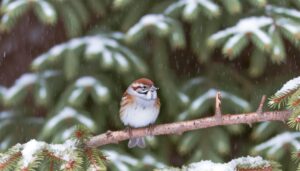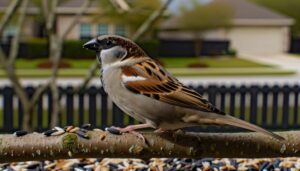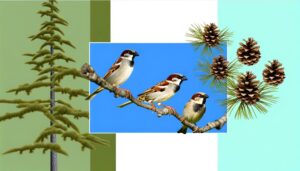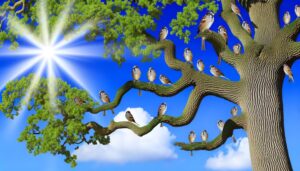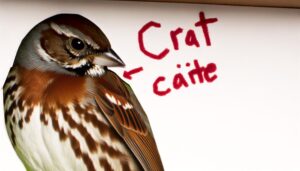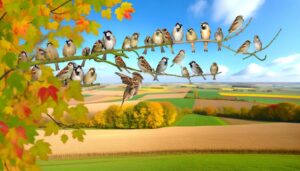Identifying Common Sparrows in Seattle
Seattle's sparrow population includes three common species: the Song Sparrow, famed for its underpart streaking; the Golden-Crowned Sparrow, distinguished by its yellow crown patch; and the White-Crowned Sparrow, renowned for its long migrations. Adapted to city life, they nest anywhere from shrubs to traffic signal boxes, evolving a diet of insects, seeds, berries, and food scraps.
With marked differences in males' coloring, they exhibit monogamous behavior during breeding seasons and display unique migrations guided by celestial and terrestrial cues. Further exploration reveals more about these adaptable birds and their varied roles within Seattle's urban ecosystem.
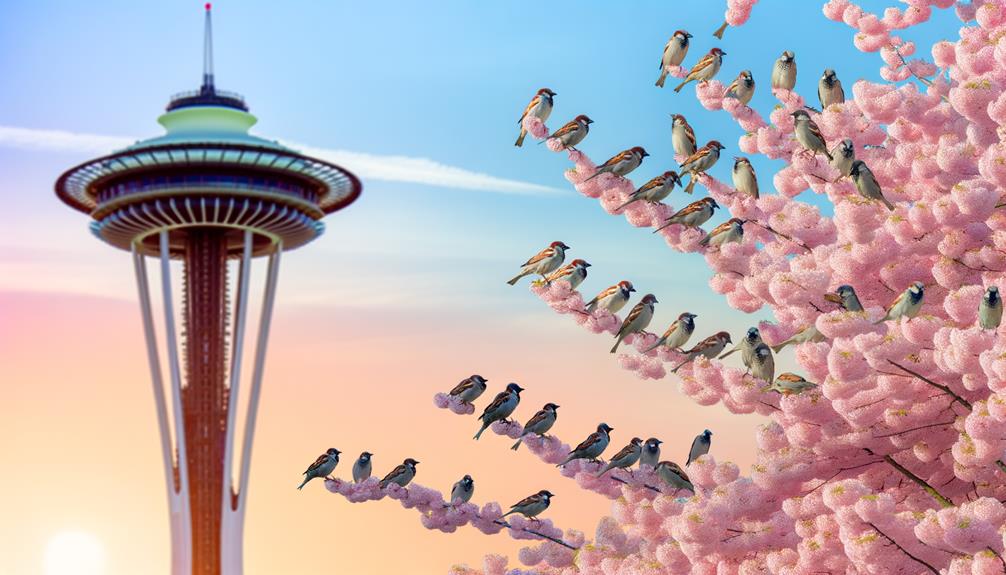
Key Takeaways
- Seattle is home to several sparrow species including the Song Sparrow, Golden-Crowned Sparrow, Fox Sparrow, and White-Crowned Sparrow.
- Sparrows in Seattle adapt to urban life by nesting in unique locations such as traffic signal boxes and human-made structures.
- These sparrows have diverse diets comprising insects, seeds, berries, and human food scraps, showing adaptability to the urban ecosystem.
- The sparrows in Seattle demonstrate calculated migratory patterns, moving to warmer climates with abundant food in late summer or early fall.
- Sparrows in Seattle exhibit significant regional variation in song and appearance, adapting to a wide range of habitats.
Identification of Seattle Sparrows
Often, you'll spot sparrows in Seattle distinguished by their unique characteristics such as their compact bodies, conical beaks, and brown or grey plumage.
These small passerine birds, typically ranging from 11 to 18 cm in length, are a common sight in the city. Their wings are robust, allowing them to be agile fliers.
Observing closely, you'll notice the males often have more distinctive markings and colors than females. For instance, the Song Sparrow, a common species in Seattle, exhibits heavy streaking on its underparts, with a dense central spot.
The male's eye-catching plumage is a spectacle, particularly during mating season. On the other hand, the female's muted tones allow her to blend into surroundings, a key survival strategy.
Sparrow Habitats in Seattle
In Seattle, sparrows exhibit a strong preference for urban nesting spots, utilizing nooks in buildings and shrubs in parks.
The city's seasonality, with its temperate summers and mild, wet winters, impacts these birds' habitation patterns to a considerable extent.
Detailed observations of these factors can contribute to a more robust understanding of sparrow habitats in Seattle.
Urban Nesting Spots
Amid the bustling cityscape of Seattle, sparrows have adapted to urban life by establishing their nests in a variety of unique and unexpected locations. These birds typically prefer areas that offer protective cover and proximity to food sources. Observations reveal that sparrows frequently nest in crevices of buildings, under bridges, and within thickets of urban vegetation.
Surprisingly, they've also been spotted nesting in traffic signal boxes and the hollowed areas of streetlights. Even more unexpected is their innovative use of human-made structures, such as gutters, awnings, and discarded objects. This adaptability to an urban environment underscores the sparrow's resourcefulness and resilience.
Seattle's sparrows exhibit a captivating case study in urban wildlife adaptation.
Impact of Seasonality
While the urban nesting habits of Seattle's sparrows are certainly fascinating, it's the seasonal changes that dramatically alter these habitats, presenting new challenges and opportunities for these resourceful birds.
During the colder months, sparrows must adapt to reduced food availability, often resorting to scavenging. Winter also sees a shift in their social structure, with birds flocking together for warmth.
Conversely, the abundance of insects and seeds in spring and summer allows sparrows to thrive, bolstering their population. However, increased daylight hours also mean longer foraging periods and heightened predator activity.
Uncovering Sparrow Diets
Most folks don't realize the remarkably diverse diets that sparrows in Seattle have developed to adapt to their urban environment. These small birds aren't picky eaters. They're omnivorous, consuming a varied diet of insects, seeds, berries, and even discarded human food.
Their diet primarily consists of seeds, making up about 60% of their total intake. Insects, an excellent protein source, account for roughly 30%, while the remaining 10% is a mix of berries and human food scraps. Interestingly, they adjust their diet seasonally, consuming more insects during spring and summer, coinciding with the insects' high population.
This diet diversity not only ensures nutritional balance but also reflects their adaptability to the changing urban ecosystem.
Sparrow Breeding Patterns
Just as these adaptable creatures vary their diet with the changing seasons, sparrows in Seattle also have distinctive breeding patterns that are worth noting. Breeding typically begins in early spring, when environmental conditions are favorable and food supply is abundant.
Three key elements of their breeding patterns are:
- Monogamy: Sparrows pair up for the breeding season, with both parents involved in raising the young.
- Multiple Clutches: Sparrows in Seattle often have more than one brood per season, which is a remarkable adaptation for increasing their survival chance.
- Nest Construction: Sparrows show a preference for building nests in sheltered areas, often high up in trees or in man-made structures, providing protection from predators and harsh weather.
These patterns illustrate the sparrows' adaptability and resilience in their urban environment.
Sparrow Migration Patterns
Shifting from breeding patterns, the discussion now turns to migration patterns of sparrows in Seattle.
The study examines seasonal travels of these birds, the factors that affect these movements, and a detailed analysis of their destination areas.
A thorough understanding of these aspects can shed light on the survival strategies of sparrows and their adaptations to various environments.
Seasonal Sparrow Travels
In Seattle, sparrows set out on their seasonal journeys, a fascinating migratory pattern that reveals much about these birds' adaptability and survival mechanisms. They're not just aimlessly fluttering about; it's a calculated expedition, a proof of their survival strategy they've honed over countless generations.
Sparrows typically begin their migration during the late summer or early fall. Their destinations vary, but the key is to find warmer climates with abundant food sources.
Science has discovered that sparrows use a combination of the sun, stars, and Earth's magnetic field to navigate during these lengthy migration flights.
Once they reach their destination, sparrows settle in until the harsh winter months pass, then they return to their original nesting areas in Seattle.
This cyclical journey is a tribute to the sparrow's resilience and adaptability.
Factors Affecting Migration
While the cyclic journey of sparrows is a demonstration of their resilience, it's also shaped by several environmental and biological factors that influence their migration patterns.
The availability of food resources, for instance, is a significant driving force. Sparrows, as opportunistic feeders, adapt their travel based on food accessibility.
The changing seasons, with its fluctuating temperatures and daylight hours, also play a crucial role. They instinctively migrate to avoid harsh weather conditions and optimize survival.
Genetic predispositions largely govern their migratory conduct. These innate behaviors have been observed to guide sparrows towards specific migratory routes, regardless of their individual experience.
It's a complex interplay of external cues and inherent tendencies that dictate sparrow migration.
Destination Areas Analysis
Sparrows navigate vast distances during migration, often settling in areas that best satisfy their needs for food, shelter, and breeding. The Seattle region, for example, provides a suitable habitat for these common sparrows due to the availability of the essentials.
- Food Sources: Seattle's natural vegetation and the city's bird-friendly policies have led to an abundance of insects, seeds, and berries, meeting sparrows' dietary needs.
- Shelter: The city's green spaces, gardens, and parks offer ample nesting and hiding spots.
- Breeding: The temperate climate and long daylight hours during spring and summer in Seattle create ideal conditions for breeding.
This analysis affirms that Seattle is a viable destination for sparrows, explaining their significant presence in the city.
The Song Sparrow: An Overview
Often spotted flitting around the urban parks and gardens of Seattle, the Song Sparrow, scientifically known as Melospiza melodia, stands out with its rich, intricate melodies and streaked, brown plumage. This medium-sized sparrow displays considerable regional variation, both in song and appearance. It typically sports a heavy, rounded bill and a fairly long, rounded tail.
Its characteristic song, a series of varied phrases often repeated, can be heard all year round. It's a resilient species, adapting to a wide range of habitats, from salt marshes to alpine meadows. However, in Seattle, they've become a common sight in urban environments, seemingly undeterred by human activity.
Their diet consists mainly of seeds, but they're known to consume insects and small invertebrates, especially during the breeding season.
Studying the Golden-Crowned Sparrow
Another species that graces the city of Seattle with its presence is the Golden-Crowned Sparrow, scientifically known as Zonotrichia atricapilla, which is easily distinguished by its golden-yellow crown patch. This medium-sized sparrow spends its winters in Seattle, offering locals and birdwatchers the chance to observe its distinctive features and behaviors.
Here are three key points to note when studying the Golden-Crowned Sparrow:
- Its song: The song of the Golden-Crowned Sparrow is a simple, melancholy whistle, often described as 'oh-dear-me' which resonates in the cool Seattle air.
- Its diet: This bird primarily feeds on seeds, berries, and insects, often foraging on the ground for its meals.
- Its habitat: While they're quite adaptable, they prefer brushy habitats, often found in gardens, parks, and scrublands around Seattle.
The Fascinating Fox Sparrow
Delighting birdwatchers with its strikingly spotted plumage, the Fox Sparrow, scientifically referred to as Passerella iliaca, makes its way through Seattle's diverse habitats, showcasing its unique traits and behaviors.
This species exhibits a sizeable, chunky body with a thick, pointed beak. Their plumage varies, but it's often noted for its rich, rufous hues and bold, splotchy patterns.
Fox Sparrows are recognized for their intricate foraging technique, known as the 'double-scratch,' where they rapidly kick backward with both feet to uncover hidden food.
Vocalizing a beautiful, complex song that's characterized by a series of clear whistles and trills, they're a melodious presence in Seattle's soundscape.
Their nests, commonly built in shrubs or on the ground, further highlight their adaptability to diverse environments.
White-Crowned Sparrow: A Closer Look
Sporting a distinctive black-and-white striped crown, the White-Crowned Sparrow, or Zonotrichia leucophrys, is a common sight in Seattle's urban and suburban landscapes. It's easily identifiable by its striking plumage, clear whistle, and dynamic behavior.
This species exhibits fascinating characteristics that set them apart:
- Plumage: The black-and-white crown striping is particularly pronounced in adult males. Females and young sparrows show less contrast, with brownish stripes instead.
- Song: White-Crowned Sparrows have a sweet, melodious song that varies regionally. It's been observed that sparrows from different areas have unique 'dialects.'
- Migration: They're migratory birds, traveling long distances from Alaska and Canada to winter in the southern United States and Mexico. This journey demonstrates their incredible endurance and navigational skills.
Sparrows and Seattle Ecosystem
Within the intricate web of Seattle's ecosystem, sparrows play an essential role in maintaining a balance, fulfilling necessary tasks such as seed dispersal and insect consumption.
As granivores, sparrows aid in the distribution of plant species by feeding on seeds and discarding them in various locations. This results in a wider dispersal of plant life, contributing to the ecosystem's diversity and resilience.
Additionally, by feasting on insects, sparrows help keep the pest population in check, naturally mitigating potential threats to both flora and fauna. Their diet varies seasonally, offering a dynamic response to fluctuating insect populations.
This adaptability makes sparrows indispensable in preserving the equilibrium of Seattle's ecosystem, emphasizing their integral role in the city's biodiversity.
Protecting Seattle's Sparrow Population
As we shift focus to the preservation of Seattle's sparrow population, it's important to take into account both the conservation efforts in place and the threats challenging these species.
The existing conservation strategies are rooted in scientific research and observation, aiming to enhance the survival and proliferation of these birds. However, without a clear understanding of the potential threats to sparrows, these efforts may not fully succeed in preserving these integral parts of Seattle's ecosystem.
Conservation Efforts for Sparrows
In an effort to safeguard the sparrow population, Seattle has implemented several conservation strategies, grounded in scientific research and careful observation. These strategies are designed with a deep understanding of the sparrow's life cycle, habitat requirements, and ecological role.
- Habitat Preservation:
The city maintains and protects green spaces, essential for the sparrows' nesting and foraging.
- Public Education:
Seattle's conservation programs raise awareness about the importance of sparrows to the ecosystem, encouraging residents to be mindful of their actions.
- Nest Box Provision:
The city provides nest boxes in strategic locations to support the sparrows' breeding.
Threats to Sparrow Species
Despite meticulous conservation efforts, several threats still loom over Seattle's sparrow population, including habitat loss, climate change, and predation.
Urban development continues to encroach on the sparrows' habitats, reducing the availability of nesting sites and food sources. In addition, climate change disrupts seasonal patterns, confusing the timing of migration and breeding. Predation, especially from domestic cats, also poses a significant risk to these birds.
Efforts to mitigate these threats are ongoing, with initiatives such as green spaces and bird-friendly buildings to counter habitat loss. Climate change, though a global issue, can be tackled locally by reducing carbon footprints. Education on responsible pet ownership can help manage predation.
However, there's a long road ahead in the fight for Seattle's sparrows.
Conclusion
Seattle's sparrows are humble yet crucial symbols of the city's thriving ecosystem. They flutter with untold stories of survival and adaptation. Their diverse diets, distinct breeding patterns, and fascinating migration routes encapsulate nature's remarkable resilience.
Species like the Fox and White-Crowned sparrows add distinctive colors to the city's biological tapestry. Safeguarding these feathered city-dwellers isn't just about conservation; it's about maintaining a crucial link in Seattle's ecological chain, a proof of the interconnectedness of life itself.

